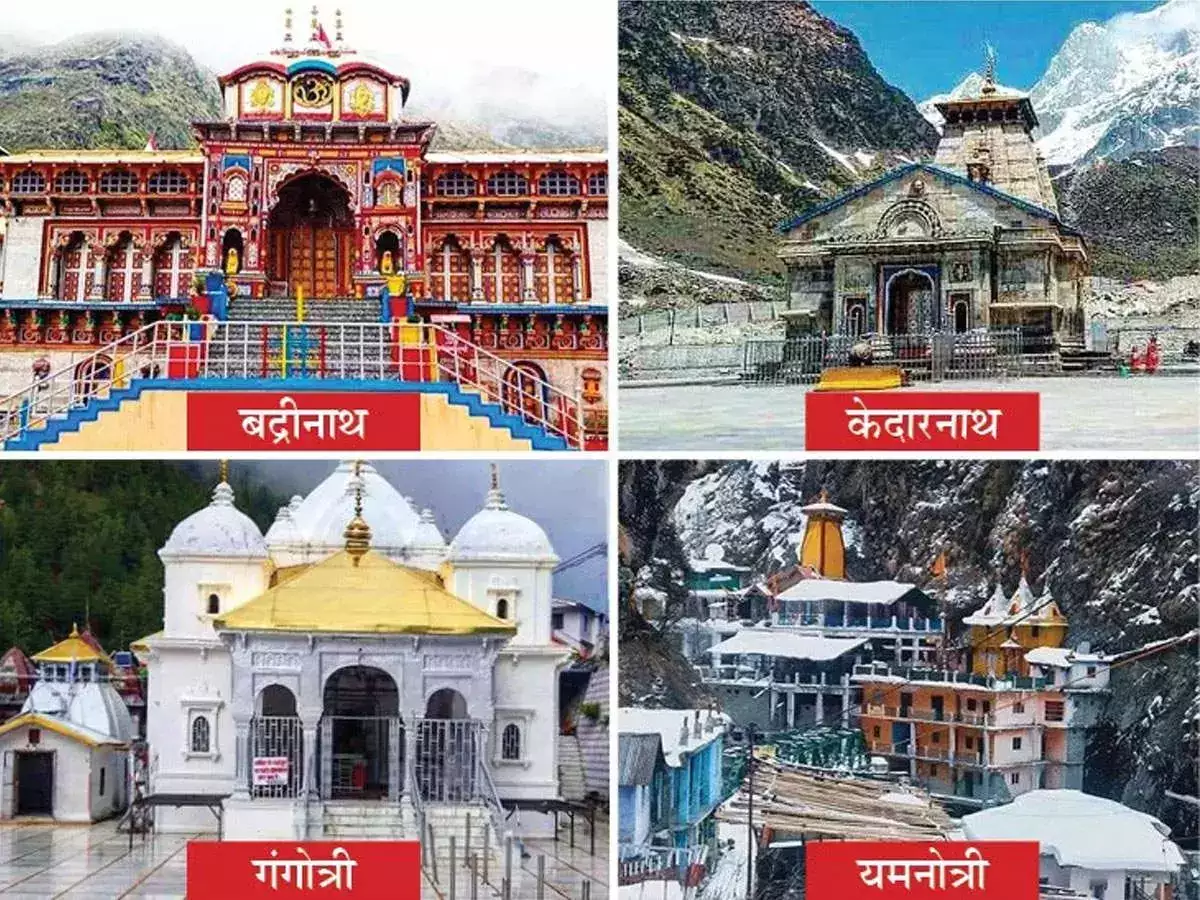
Char Dham Temple Tour Uttarakhand: A Comprehensive Guide to India’s Sacred Pilgrimage
The Char Dham Temple Tour in Uttarakhand is one of the most sacred and sought-after pilgrimages in India, attracting millions of devotees and spiritual seekers every year. Nestled in the majestic Himalayan range, the Char Dham circuit comprises four holy shrines: Yamunotri, Gangotri, Kedarnath, and Badrinath. These shrines are revered in Hinduism, and it is believed that undertaking the Char Dham Yatra cleanses the soul of all sins and ensures moksha (salvation). Each temple holds its own unique significance, and the journey through Uttarakhand’s divine landscape offers not only spiritual fulfillment but also breathtaking views of pristine rivers, towering peaks, and lush forests.
The Char Dham Yatra usually begins in April or May and continues until October, taking pilgrims through some of the most scenic and challenging terrains in India. The journey not only offers spiritual enlightenment but also a deep connection to nature, as travelers traverse through snow-capped peaks, verdant valleys, and crystal-clear rivers. Each temple visit provides a unique experience—whether it’s the peaceful waters of Yamunotri or the majestic backdrop of Kedarnath. For those seeking spiritual fulfillment and adventure, the Char Dham Yatra in Uttarakhand is a transformative journey that promises both divine blessings and an unforgettable experience in the lap of the Himalayas.
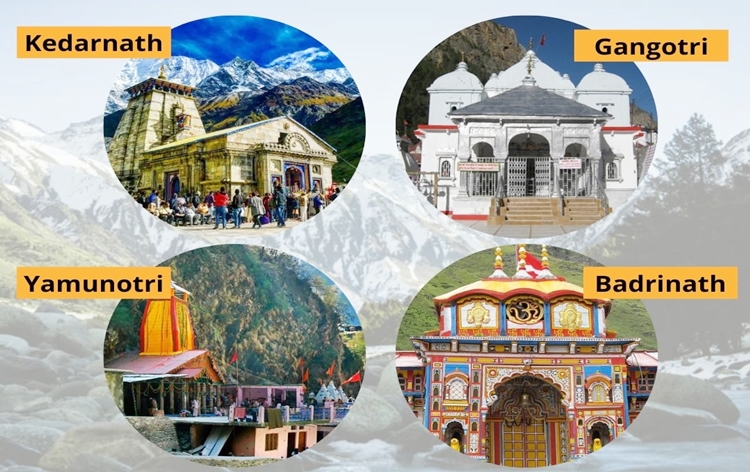
1. Understanding the Char Dham Temple Tour Uttarakhand
The Char Dham Yatra refers to the pilgrimage to the four sacred temples, each dedicated to a different deity and representing different facets of spirituality:
- Yamunotri: Dedicated to Goddess Yamuna, this temple is the starting point of the Yatra and is located at the source of the Yamuna River.
- Gangotri: Dedicated to Goddess Ganga, the temple is situated at the origin of the holy Ganges River.
- Kedarnath: One of the twelve Jyotirlingas dedicated to Lord Shiva, Kedarnath is one of the most significant Shiva temples in India.
- Badrinath: The final stop of the Yatra, Badrinath is dedicated to Lord Vishnu and is part of the larger Char Dham circuit that also includes temples in Dwarka, Rameswaram, and Puri.
The Char Dham Yatra typically starts in late April or early May and continues until October, after which the temples close for the winter due to heavy snowfall. The route covers an arduous journey through winding mountain roads and involves both trekking and driving, offering a deeply immersive experience in the natural beauty and spiritual sanctity of the region.
2. Significance of Each Char Dham Shrine
a. Yamunotri Temple
Yamunotri, located at an altitude of 3,293 meters, is the source of the Yamuna River and is considered the seat of Goddess Yamuna. According to Hindu mythology, Yamuna is the sister of Yama, the God of Death, and it is believed that taking a dip in the waters of Yamunotri can cleanse one of their sins and protect them from an untimely death.
The temple is perched on the western side of the Bandarpunch Peak, surrounded by lofty Himalayan mountains. The trek to Yamunotri is a 6 km journey from the town of Janki Chatti, and devotees must cross rugged terrain and steep slopes. Along the way, there are several natural hot water springs, such as the famous Surya Kund, where pilgrims cook rice and potatoes as offerings to the Goddess.
The Yamunotri Temple itself, originally constructed by Maharani Guleria of Jaipur in the 19th century, has undergone several restorations due to natural calamities. However, its spiritual allure remains undiminished, attracting both devotees and adventure seekers alike.

b. Gangotri Temple
Gangotri is located at an altitude of 3,100 meters and is the origin of the holy Ganges River, which is regarded as the most sacred river in Hinduism. The Ganges is believed to have descended from heaven to earth at Gangotri after being requested by King Bhagirath to wash away the sins of his ancestors.
The Gangotri Temple, built in the early 18th century by a Gorkha commander, stands against the backdrop of the majestic Ganga River and the towering Himalayan peaks. Pilgrims visit Gangotri to pay homage to Goddess Ganga and to purify themselves in the holy waters of the Ganges. The main attraction here is the Bhagirathi Shila, a rock where it is believed that King Bhagirath meditated to bring the Ganges down to earth.
The source of the Ganges is the Gaumukh Glacier, located about 18 km from Gangotri. Many devotees choose to trek to Gaumukh, a journey that offers an intimate connection with nature and the divine.
c. Kedarnath Temple
Kedarnath, situated at an elevation of 3,583 meters, is the most remote of the four Char Dham temples and is dedicated to Lord Shiva. It is one of the twelve Jyotirlingas and holds a prominent place in Hindu mythology. The temple is believed to have been built by the Pandavas during the Mahabharata era, though the current structure was constructed by Adi Shankaracharya in the 8th century.
Kedarnath is located near the head of the Mandakini River and is surrounded by snow-covered peaks, making it one of the most scenic yet challenging pilgrimages. The journey to the temple involves a 16 km trek from Gaurikund, which can be undertaken on foot, by pony, or via helicopter services for those seeking an easier route.
Kedarnath is not only a place of pilgrimage but also a site of extraordinary natural beauty, with towering peaks, glaciers, and deep valleys. The temple was one of the few structures to withstand the devastating 2013 Uttarakhand floods, which only reinforced its status as a divine and invincible place.

d. Badrinath Temple
Badrinath, located at an altitude of 3,133 meters, is the last stop on the Char Dham Yatra and is dedicated to Lord Vishnu. Badrinath is part of both the Char Dham (four abodes) and the Chota Char Dham circuits. According to legend, Lord Vishnu meditated here under the Badri tree for thousands of years, earning the name Badri Vishal.
The Badrinath Temple is situated along the banks of the Alaknanda River, and it is flanked by the towering Nar and Narayan mountains. One of the temple’s unique features is the hot springs, known as the Tapt Kund, where devotees take a dip before entering the temple to purify themselves.
The town of Badrinath is not only known for its religious significance but also for its picturesque beauty, with the Neelkanth Peak in the background offering a stunning view. The temple is accessible by road and is well connected to other parts of Uttarakhand.
3. The Spiritual Benefits of the Char Dham Yatra
The Char Dham Yatra is more than just a journey to four temples; it is a path of self-discovery, spiritual growth, and purification. According to Hindu belief, visiting the four shrines is a way to cleanse oneself of all past sins, experience spiritual renewal, and attain moksha (salvation). The Yatra is often undertaken by those seeking divine blessings, redemption, and peace.
Many devotees experience profound moments of connection with the divine while trekking through the serene and challenging Himalayan landscapes. Each temple provides a unique spiritual experience:
- At Yamunotri, the peaceful surroundings and the icy cold waters of the Yamuna River offer a moment of introspection and renewal.
- At Gangotri, the might of the Ganges River reminds devotees of the power of purification and the cycle of life and death.
- Kedarnath invokes a sense of awe and reverence, with its temple standing against the powerful forces of nature as a testament to faith and resilience.
- At Badrinath, the final temple, the serene environment and the presence of Lord Vishnu offer closure and fulfillment, making it a deeply enriching experience.
4. Best Time to Visit the Char Dham Temples
The best time to undertake the Char Dham Yatra is from May to October, with the temples opening in late April or early May and closing just after Diwali in October or early November. This is the period when the weather is most favorable for travel, though conditions can still be unpredictable due to the high altitude and mountainous terrain. During the monsoon season, from July to September, landslides and road blockages are common, which can make travel hazardous. Therefore, it is advised to plan the trip either in May-June or post-monsoon in September-October.
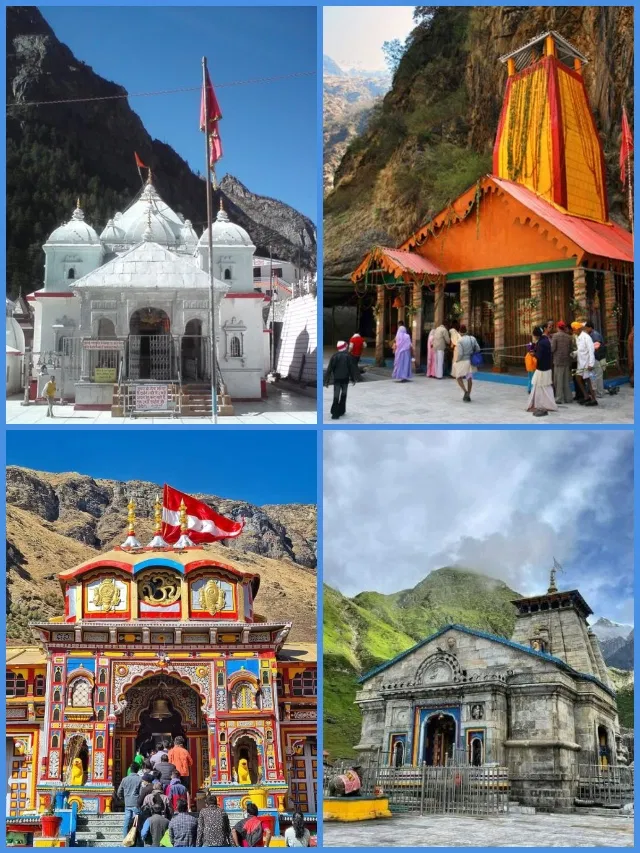
5. How to Plan the Char Dham Yatra
Planning a Char Dham Temple Tour requires careful consideration of travel routes, accommodation, and fitness levels. The four temples are located in remote areas of Uttarakhand, and while some can be reached by road, others require trekking. It is essential to ensure that you are physically fit for the journey, especially the trek to Kedarnath.
Here’s a typical itinerary for the Char Dham Yatra:
- Haridwar/Rishikesh: Most pilgrims start their journey from Haridwar or Rishikesh, two spiritual hubs located at the foothills of the Himalayas.
- Yamunotri: The first stop, a trek from Janki Chatti (6 km) leads to the Yamunotri temple.
- Gangotri: After Yamunotri, head towards Gangotri via Uttarkashi. The temple is accessible by road.
- Kedarnath: From Gangotri, the next destination is Kedarnath, where a 16 km trek from Gaurikund awaits.
- Badrinath: The final destination is Badrinath, which is accessible by road from Kedarnath via Rudraprayag.
Discover the Spiritual Essence of Uttarakhand: The Ultimate Char Dham Yatra Journey”
The Char Dham Yatra is one of India’s most revered pilgrimages, drawing devotees and spiritual seekers from all over the world. Nestled in the majestic Himalayan region of Uttarakhand, the Char Dham circuit includes four sacred temples: Yamunotri, Gangotri, Kedarnath, and Badrinath.
Each temple holds its own unique significance, with Yamunotri being the source of the Yamuna River, Gangotri as the origin of the sacred Ganges, Kedarnath dedicated to Lord Shiva, and Badrinath to Lord Vishnu. Embarking on this journey offers not only spiritual fulfillment but also a chance to experience the breathtaking beauty of the Himalayas. Whether it’s the challenging trek to Kedarnath or the tranquil surroundings of Gangotri, each site offers a deep connection to nature and divinity. This tour is an enriching journey of faith and devotion, perfect for anyone looking to reconnect with their spiritual roots.
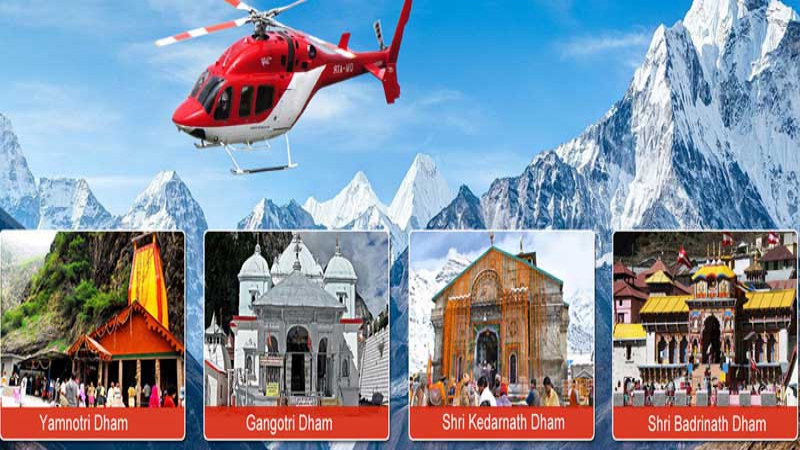
Char Dham Yatra: A Himalayan Pilgrimage Through the Sacred Temples of Uttarakhand
The Char Dham Yatra in Uttarakhand is a pilgrimage of immense significance in Hindu tradition, offering spiritual purification and blessings. This sacred journey takes you through the serene and often snow-clad landscapes of the Himalayas, visiting four of the holiest temples in the region—Yamunotri, Gangotri, Kedarnath, and Badrinath. Each temple has a deep spiritual connection, associated with various Hindu gods and rivers.
The tour begins at Yamunotri, the source of the Yamuna River, and continues to Gangotri, the origin of the sacred Ganges. Next is Kedarnath, one of the twelve Jyotirlingas dedicated to Lord Shiva, and finally, Badrinath, where Lord Vishnu is worshipped. The pilgrimage is not just about temple visits; it also offers a profound experience of Uttarakhand’s natural beauty, from dense forests and serene valleys to the towering Himalayan peaks. The Char Dham Yatra is a journey of both physical endurance and spiritual elevation.
Experience Divinity at Its Peak: Exploring the Char Dham Temples of Uttarakhand
The Char Dham temples of Uttarakhand—Yamunotri, Gangotri, Kedarnath, and Badrinath—are not only places of religious significance but are also located in some of the most beautiful and serene landscapes in the world. This sacred pilgrimage is a journey that combines devotion with adventure.
Each temple is dedicated to a different deity, symbolizing various aspects of life and spirituality. Yamunotri, the first stop, is dedicated to Goddess Yamuna, offering a tranquil start to the journey. Gangotri, the next destination, represents purity and life as it is the source of the holy Ganges River. Kedarnath, dedicated to Lord Shiva, sits majestically amidst snow-capped mountains, offering a peaceful yet powerful spiritual experience. The tour ends with a visit to Badrinath, where Lord Vishnu resides, providing a sense of completion and fulfillment. This journey through the Himalayas is not just a tour of temples, but a path to rediscover oneself through nature and faith.

Char Dham Yatra: A Spiritual Odyssey through Uttarakhand’s Sacred Shrines
Uttarakhand, often referred to as Devbhumi or the Land of the Gods, is home to one of the most significant spiritual journeys in India—the Char Dham Yatra. This pilgrimage takes travelers to four holy shrines: Yamunotri, Gangotri, Kedarnath, and Badrinath, located in the lap of the Himalayas.
The Char Dham Yatra is not just a tour of temples, but a deeply spiritual journey that promises redemption and inner peace. Beginning at Yamunotri, pilgrims honor the goddess Yamuna, followed by a visit to Gangotri, the origin of the sacred Ganges. Kedarnath, revered as one of the twelve Jyotirlingas of Lord Shiva, is a highlight for many, and the journey concludes at Badrinath, a temple dedicated to Lord Vishnu. The tour is physically demanding but spiritually rewarding, as pilgrims often experience a profound connection to both the divine and the natural world around them. Every step of the journey is marked by awe-inspiring landscapes and deep devotion.
Embark on a Sacred Pilgrimage: The Char Dham Temple Tour of Uttarakhand
A Char Dham Temple tour in Uttarakhand offers a perfect blend of spiritual reverence and adventure. This sacred pilgrimage, which takes you to four of India’s holiest temples—Yamunotri, Gangotri, Kedarnath, and Badrinath—is considered one of the most auspicious journeys for a Hindu devotee. It’s believed that a visit to these temples will cleanse the soul and lead to moksha, or salvation. Yamunotri is the starting point of the Yatra, known for the Yamuna River and its peaceful surroundings. Gangotri follows, offering a spiritually invigorating experience as pilgrims pay homage to the Ganges.
The journey continues to Kedarnath, nestled in the mountains and dedicated to Lord Shiva. The tour concludes at Badrinath, where Lord Vishnu blesses his devotees. Beyond the religious significance, the Char Dham tour also gives travelers an opportunity to immerse themselves in the stunning natural beauty of the Himalayas, with snow-capped peaks, dense forests, and crystal-clear rivers accompanying them every step of the way.
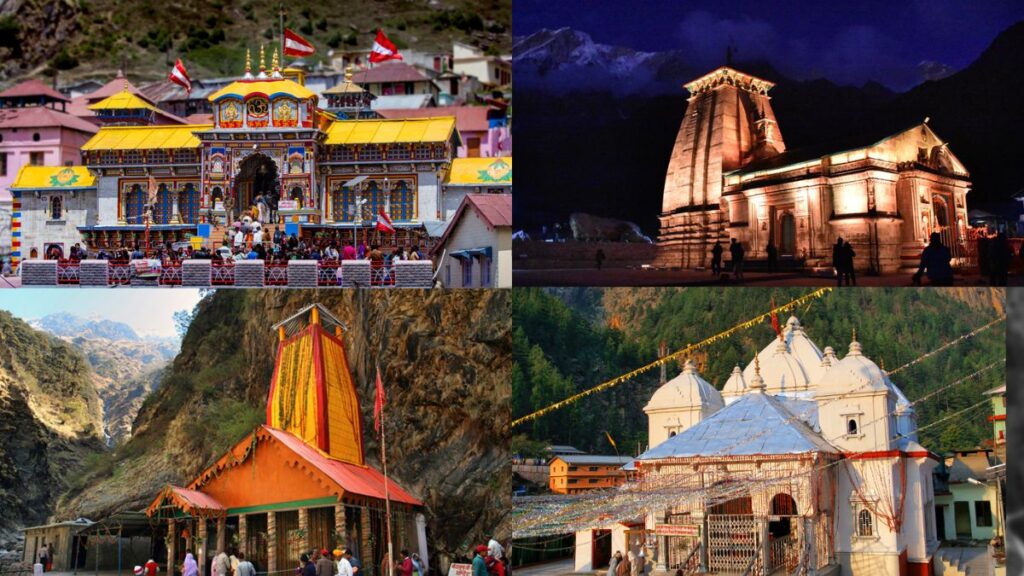
Conclusion
The Char Dham Temple Tour in Uttarakhand is not just a pilgrimage but a journey that offers a blend of spirituality, adventure, and the unparalleled beauty of nature. It is a soul-stirring experience that takes you to the very heart of the Himalayas, where divinity and nature coexist in harmony. For those seeking spiritual enlightenment, the Char Dham Yatra is a must-do pilgrimage, offering not only divine blessings but also memories of a lifetime.
The journey through Yamunotri, Gangotri, Kedarnath, and Badrinath connects one deeply to India’s ancient spiritual roots while also serving as a personal retreat from the chaos of everyday life. Whether you are a devout pilgrim or a nature lover, the Char Dham Yatra promises an experience like no other.








Leave a Reply